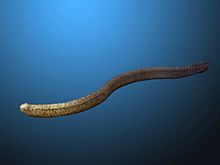The Ordovician is a geologic period and system, the second of six periods of the Paleozoic Era. The Ordovician spans 41.6 million years from the end of the Cambrian Period 485.4 million years ago (Mya) to the start of the Silurian Period 443.8 Mya.

Conodonts are an extinct group of agnathan (jawless) Fish resembling eels, classified in the class Conodonta. For many years, they were known only from their tooth-like oral elements found in isolation and now called conodont elements. Knowledge about soft tissues remains limited. They existed in the worlds oceans for over 300 million years, from the Cambrian to the beginning of the Jurassic. Conodont elements are widely used as index fossils, fossils used to define and identify geological periods. The animals are also called Conodontophora to avoid ambiguity.

The choreotrichs are a group of small marine ciliates. Their name reflects the impression that they appear to dance. The group includes the tintinnids, which produce species-specific loricae (shells), and are important because these may be preserved as microfossils. The cyst forms have been suggested to be affiliated to Chitinozoans, although other studies suggest Chitinozoans to have affinities to larger marine animals, and not tintinnids. Often they have been included among the oligotrichs. Tintinnids seem to be an excessively specious group as over 400 living species have been described, based on characteristics of the lorica or shell.
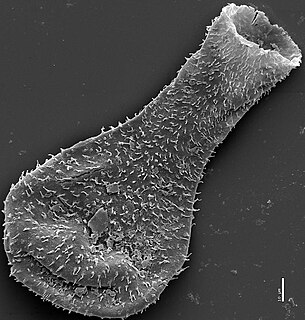
Chitinozoa are a taxon of flask-shaped, organic walled marine microfossils produced by an as yet unknown organism. Common from the Ordovician to Devonian periods, the millimetre-scale organisms are abundant in almost all types of marine sediment across the globe. This wide distribution, and their rapid pace of evolution, makes them valuable biostratigraphic markers.
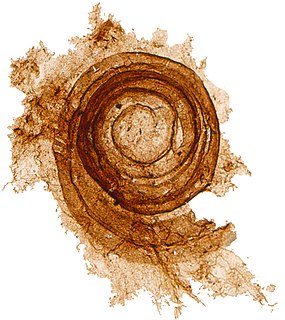
A microfossil is a fossil that is generally between 0.001 mm and 1 mm in size, the visual study of which requires the use of light or electron microscopy. A fossil which can be studied with the naked eye or low-powered magnification, such as a hand lens, is referred to as a macrofossil.

The Cambrian–Ordovician extinction event occurred approximately 488 million years ago (m.y.a.). This early Phanerozoic Eon extinction event eliminated many brachiopods and conodonts, and severely reduced the number of trilobite species. The Period in the Cambrian extinction in which most of the extinction occurred was the Caerfai Period.
Bromalites are the fossilised remains of material sourced from the digestive system of organisms. As such, they can be broadly considered to be trace fossils. The most well-known types of bromalites are fossilised faeces or coprolites. However, other types are recognised, including: regurgitalites ; cololites ; and gastrolites. Regurtitalites and coprolites are thus essentially known only after they have left the body of the producing organisms, whereas gastrolites and cololites are found in situ in their respective organs, but there are rare exceptions.

Onychopterella is a genus of predatory eurypterid, an extinct group of aquatic arthropods. Fossils of Onychopterella have been discovered in deposits from the Late Ordovician to the Late Silurian. The genus contains three species: O. kokomoensis, the type species, from the Early Pridoli epoch of Indiana; O. pumilus, from the Early Llandovery epoch of Illinois, both from the United States; and O. augusti, from the Late Hirnantian to Early Rhuddanian stages of South Africa.
Michelinoceras is the oldest known genus of the Michelinocerida, more commonly known as the Orthocerida, characterized by long, slender, nearly cylindrical orthocones with a circular cross section, long camerae, very long body chambers, and a central or near central tubular siphuncle free of organic deposits. Septal necks are straight; connecting rings cylindrical and thin. Cameral deposits are well developed. A radula has been found in one species, with seven teeth per row. It had ten arms, two of which formed longer tentacles.
The Burgess Shale of British Columbia is famous for its exceptional preservation of mid-Cambrian organisms. Around 69 other sites have been discovered of a similar age, with soft tissues preserved in a similar, though not identical, fashion. Additional sites with a similar form of preservation are known from the Ediacaran and Ordovician periods.

Class Xenusia, the Xenusiids, represents the subset of lobopodian worms that fall in the stem-lineage of Onychophora. Their type genus is Xenusion. They have relatively large, annulated, cylindrical bodies. Their lobopod legs have tubercles at their bases. Some have large frontal appendages, although these may represent taphonomic artefacts. Their mouth is terminal or subterminal, and they are marine. They probably represent a grade rather than a clade.

Eldonia is an extinct soft-bodied cambroernid animal of unknown affinity, best known from the Fossil Ridge outcrops of the Burgess Shale, particularly in the 'Great Eldonia layer' in the Walcott Quarry. In addition to the 550 collected by Walcott, 224 specimens of Eldonia are known from the Greater Phyllopod bed, where they comprise 0.43% of the community. Species also occur in the Chengjiang biota, and in Upper Ordovician strata of Morocco.

Archeognathus is a fossilized jaw apparatus of a large predatory conodont from the Ordovician period. Its large size has made classification difficult, and it has historically been compared to conodonts and gnathostomes since its remains were first discovered in Missouri. Complete articulated jaw apparatus of Archeognathus primus are common in the Winneshiek Shale lagerstätte of Iowa, allowing its identity as a conodont to be secured.
Prioniodontida, also known as the "complex conodonts", is a large clade of conodonts that includes two major evolutionary grades; the Prioniodinina and the Ozarkodinina. It includes many of the more famous conodonts, such as the giant ordovician Promissum (Prioniodinina) from the Soom Shale and the Carboniferous specimens from the Granton Shrimp bed (Ozarkodinina). They are euconodonts, in that their elements are composed of two layers; the crown and the basal body, and are assumed to be a clade.
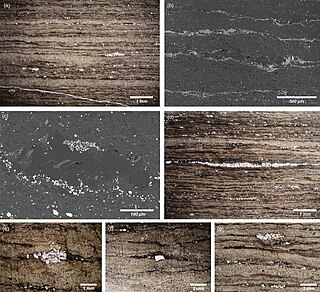
The Soom Shale is a member of the Late Ordovician (Hirnantian) Cederberg Formation in South Africa, renowned for its remarkable preservation of soft-tissue in fossil material. Deposited in still waters, the unit lacks bioturbation, perhaps indicating anoxic conditions.
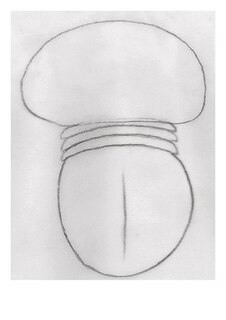
Soomaspis is a genus of small to average size marine arthropods in the Liwiidae Family, that lived during the late Ordovician. Fossil remains of Soomaspis were collected from the Soom Shale Lagerstätte in Western Cape, South Africa. Soomaspis looks like a large, soft agnostid trilobite. It has a headshield wider than the tailshield (pygidium), and in between them three thoracic body segments (somites). The genus is monotypic, its sole species being Soomaspis splendida.

The evolution of fish began about 530 million years ago during the Cambrian explosion. It was during this time that the early chordates developed the skull and the vertebral column, leading to the first craniates and vertebrates. The first fish lineages belong to the Agnatha, or jawless fish. Early examples include Haikouichthys. During the late Cambrian, eel-like jawless fish called the conodonts, and small mostly armoured fish known as ostracoderms, first appeared. Most jawless fish are now extinct; but the extant lampreys may approximate ancient pre-jawed fish. Lampreys belong to the Cyclostomata, which includes the extant hagfish, and this group may have split early on from other agnathans.
Balognathidae is an extinct conodont family.
Notiodella is an extinct conodont genus in the family Balognathidae. It has been described from a 17-element apparatus from the Soom Shale Lagerstätte in South Africa.

The Winneshiek Shale is a Middle Ordovician (Darriwilian-age) geological formation in Iowa. The formation is restricted to the Decorah crater, an impact crater near Decorah, Iowa. Despite only being discovered in 2005, the Winneshiek Shale is already renowned for the exceptional preservation of its fossils. The shale preserves a unique ecosystem, the Winneshiek biota, which is among the most remarkable Ordovician lagerstätten in the United States. Fossils include the oldest known eurypterid, Pentecopterus, as well as giant conodonts such as Iowagnathus and Archeognathus.
